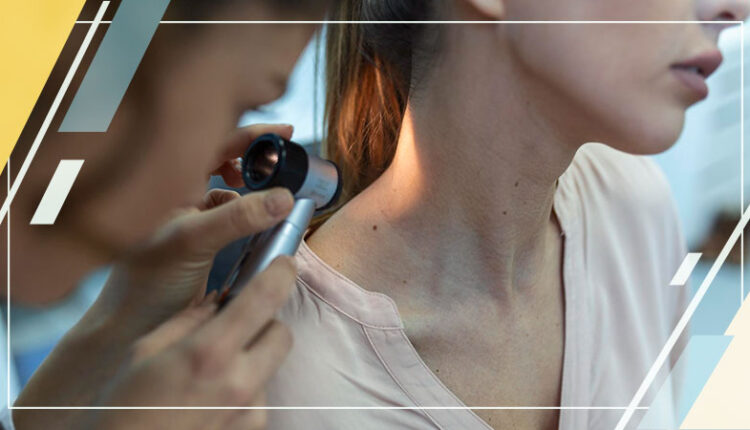Dermatoscopy is the convergence point where the naked eye meets advanced diagnostic precision. In the realm of dermatology, the dermatoscope emerges as a transformative tool, unlocking a closer look at skin lesions and imperfections that may hold vital diagnostic clues. This blog delves into the world of this technology, exploring its significance, applications, and the impact they have on accurate skin lesion assessments.
Let’s explore this technology in more detail.
An Introduction to Dermatoscope
A dermatoscope is a portable instrument that individuals or medical professionals can utilize to visually examine and diagnose various skin conditions, including melanoma. Additionally, it can prove beneficial in examining the nails, hair, and scalp. The benefit of utilizing this technology is its ability to provide additional detail, which can be instrumental in the early detection of various diseases.
● Examination
With the utilization of this tool, a dermatologist can examine a patient’s skin with enhanced precision and clarity, thanks to the inclusion of light and magnification.
Using the tool allows for the visualization of characteristics present in the outermost layer of the skin that would normally be undetectable.
● Diagnosis
The tool can enhance a physician’s visual acuity when examining the skin, facilitating the identification and diagnosis of skin conditions such as melanoma.
In a comprehensive analysis conducted in 2018, researchers found that the utilization of a dermatoscope yielded higher efficacy in diagnosing melanoma compared to solely relying on a visual inspection of a skin lesion.
Dermoscopy, a method that utilizes a dermatoscope, has been found in a 2019 review to be beneficial in the identification of both cancerous and noncancerous skin abnormalities.
How Deep Can a Dermatoscope See?
Dermatoscopes offer physicians the capability to inspect and distinguish unique colors, patterns, and shapes that assist in distinguishing and diagnosing various skin ailments.
Skin lesions
A 2019 study analyzed the role of dermatoscopes in diagnosing various types of cancerous and non-cancerous skin lesions. The findings of the review shed light on how it can be beneficial in determining accurate diagnoses. The clinician can utilize the tool to identify potentially cancerous lesions, including:
- melanoma
- basal cell carcinoma
- nodular melanoma
- Merkel cell carcinoma
- Bowen’s disease
Furthermore, alternative considerations include non-cancerous lesions such as:
- dermatofibromas
- warts
A dermatologist might sometimes utilize a dermatoscope to inspect conditions that do not involve lesions, such as:
- melasma
- hair loss
- scabies
Precision of Dermatoscopes: Are They Truly Accurate?
In 2018, a Cochrane study concluded that the use of dermatoscopes, when wielded by a qualified professional, enhances diagnostic reliability for melanomas compared to relying on the naked eye alone. This finding is crucial as it has the potential to save time and assist in determining the optimal treatment approach.
Moreover, a 2019 review emphasizes that clinicians can achieve accurate diagnoses of melanomas by incorporating dermatoscopy into their assessments, taking into account specific additional factors. These additional considerations include:
- medical history
- family history
- age
If the diagnosis remains uncertain, a biopsy can be performed to gain further clarity.
Factors that can affect the accuracy
Dermatoscopes can provide significant advantages to doctors compared to relying solely on the naked eye. However, it is important to acknowledge that there are several factors that can potentially impact their accuracy.
- Unclean skin
It is crucial for a physician to meticulously cleanse the skin or hair surface prior to utilizing the tool, particularly when examining the face. Failure to do so may result in inaccurate images captured by it.
Potential factors residing on the skin or hair that could hinder the accuracy of a diagnosis encompass the following:
- makeup
- henna
- hair dye
- sunscreen
- dust
- Darker skin tones
Certain illnesses may be easier to recognize in individuals with lighter skin tones. A darker complexion can obscure or camouflage certain disease symptoms. For instance, healthcare professionals often examine skin abnormalities for colors such as black, brown, grey, and blue. However, on individuals with darker skin tones, these colors might not be as easily noticeable.
The vast majority of studies conducted on skin abnormalities have predominantly focused on individuals with lighter skin tones, possibly contributing to this observed inconsistency. Results obtained from individuals with darker skin tones might necessitate careful interpretation by medical professionals.
Final Thoughts
The dermatoscope stands as a beacon of progress in the field of dermatology, offering clinicians an invaluable window into the intricacies of skin lesions. From its roots in enhancing melanoma diagnoses to its broader applications in dermatological assessments, the technology has become a cornerstone of modern skin care. As technology continues to evolve, so too will the capabilities of this remarkable tool, promising a future where dermatoscopy plays an increasingly pivotal role in ensuring precise, timely, and effective skin disorder diagnoses.


